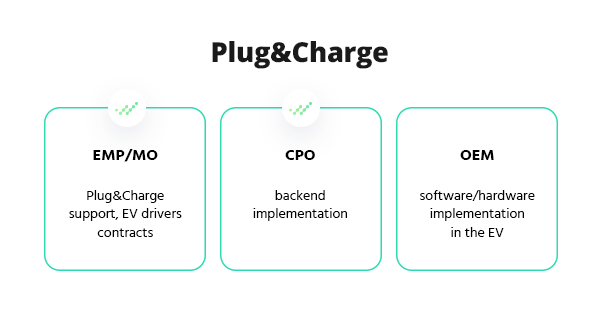Plug&Charge – the top EV innovation from 2022
Since the very beginning of the EV charging market emerging there was this idea of a seamless, fully touchless charging experience – no apps, no internet needed, full speed. This ultimate goal just got a little closer with the newest technology from Hubject – Plug and Charge protocol. This new easy to use solution enables EV drivers to automatically identify themselves at the charging station by just plugging in the cable.
The new electric vehicle charging process – quick&easy
Plug.
The first step in any electric vehicle charging is always verification. In the current stage, identification is mostly based on apps or RFID cards. The most life-changing functionality that comes with OPCP – affects significantly this stage. Electric vehicles (EV’s) send all customer data required for verification directly to the charging stations as soon as they’re plugged in. Charging stations have the ability to process authorization and allow charging without additional information. Hence apps and RFID cards are no longer needed.
& Charge.
The ultra-quick authorization gives EV owners a feeling of fully automatic charging. While in reality, the charging event starts after the confirmation from the charging station. Charging with Plug and Charge protocol is following the ISO15118 standard guidelines to ensure the security of the authorization and the payment process are secure throughout the whole process. So you Plug, Charge and Pay without any additional steps.
The new standard of charging electric vehicles
OPCP (Open Plug and Charge Protocol) is the universal protocol for all EV manufacturers, charging station manufacturers, and charge point operator that mimics the solution first introduced in Tesla.
It is believed that the ultimate goal of e-mobility — a real positive influence on our environment — lies in the introduction and adoption of Plug and Charge technology. This solution has a great potential of influencing the mass adoption of electric vehicles thanks to its ability to make charging a completely seamless experience. Thus making transportation better for our environment.
Seamless yet secure charging
During a charging event, security is of utmost importance. A transaction includes the exchange of sensitive information about the vehicle and the owner between the EV and the charging station. It’s crucial to protect all the charging networks from third-party involvement. The best way to ensure data integrity is to follow the ISO15118 standard.

ISO15118 is the most rigorous standard for vehicle-to-grid communication, specifying the ways the vehicle exchanges information with a charging station. The standard also describes preconditions for identification with the charging cable or Wi-Fi enabling the identification process and charge session.
When a connection between an electric vehicle and a charging station is established, all identification and authorization happen through a highly secure communications loop to ensure safety. Each vehicle has assigned an individual billing account (family, corporate, personal, other) that allows automatic authentification to the charging network. Then the system build-in the charger validates the information and begins charging. In the end the whole transaction is being properly registered in the backend system.
ISO15118 is still a new standard and the amount of charging devices and vehicle manufacturers that support the technology has to grow significantly before Plug&Charge will be able to take over the global market.
Plug&Charge charges up the future of emobility
Plug&Charge is a complete revolution of customer experience in the entire ecosystem in EV charging. It significantly shortens the time that customers have to spend. The only thing that they have to do is connect with a charger via cable for AC and DC charging vehicles or Wi-Fi for wireless charging.
The goal of the entire industry is to deliver EV owners cutting-edge features that will encourage new potential customers and thus make a significant change in the environmental burden caused by transportation.

Currently, not all vehicles on the market are allowing the built-in private key that enables transmitting user information via charging cable. It’s predicted to change quickly as the ISO15118 standard is being supported by manufacturers of charging stations and electric vehicles are starting to support the technology.
contact us
Need expert guidance on your next energy project?
Reach out to us and discover how Codibly can offer tailored solutions to drive your business.